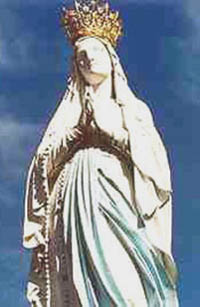 |
Feast Days of Our Lady
Our Lady of Lourdes – February 11
Prof. Plinio Corrêa de Oliveira
The story of Lourdes, where Our Lady appeared to St. Bernadette Soubirous, is rich in lessons for us. One lesson is about suffering. We see in Lourdes two attitudes of Divine Providence with regard to human suffering that can appear to be contradictory.
On one hand, the thing that attracts the most attention at Lourdes is that Our Lady has pity on men, hears their requests, and works miracles to free them from the pain and illnesses they suffer. Also, Our Lady has pity on souls, and to prove that the Catholic Faith is the only true religion, she often works spiritual miracles of conversions. By making both physical and spiritual miracles, she shows that she is our Mother who loves us and wants to relieve us from suffering both here and in eternity.

At Lourdes, Our Lady works many miracles of body and soul for the benefit of souls
|
On the other hand, we see something else at Lourdes. A great number of sick people go to Lourdes and return without being cured. Why does Our Lady give cures to some, and not to others? In fact, there is an important lesson for us in the cures she doesn’t give, and perhaps the greatest miracle of Lourdes is found precisely in this.
For the great majority of persons, suffering is indispensable for their own sanctification. Therefore, the illnesses and troubles they suffer are necessary. It is through sicknesses and spiritual tribulations that they will sanctify themselves. One who does not understand the role of suffering and sorrow in bringing about detachment, conversion, and love of God does not understand what the spiritual life really is.
St. Francis of Sales used to affirm that suffering is the Eighth Sacrament. It is so indispensable that he considered that no one could be saved without it. Cardinal Pedro Segura, Archbishop of Seville, who was an admirable Spanish Catholic, once told me about a talk he had with Pope Pius XI.
Pius XI boasted to him that he had never been sick. The Cardinal told him: “So, Your Holiness does not have the sign of the elect soul.” The Pope was surprised, but Cardinal Segura was resolute: “There is no predestined soul who does not suffer profoundly from sickness at least once in his lifetime. If Your Holiness has never had any health problem, you do not have the sign of the elect.” Some days later, Pius XI had a strong heart attack. From his bed he wrote a message to Cardinal Segura, saying: “Your Eminence, now I also have the sign of the elect.”
I agree with Cardinal Segura that suffering – be it physical or moral – is the sign of the elect soul.
Now then, Our Lady would work against the salvation of souls if she would cure every illness. Sometimes she does, because it is for the ultimate good of that person to be relieved of the suffering. But normally it is not opportune. This is why Our Lady, who is the Mother of Mercy, permits suffering for some souls, because it is indispensable.
But Our Lady also does something else that is very beautiful. To the sick persons she does not cure, she gives a profound conformity to the will of God and acceptance of their sufferings. I have never heard of a person who had been to Lourdes and was not cured who became angry and revolted against God. On the contrary, persons who go there return with an enormous resignation, happy to have been at Lourdes and seen other people being cured.

Our Lady in the grotto at Lourdes
|
Further, there are numerous cases of persons who travel long distances, arrive at Lourdes, and witness other persons who are suffering much more than they are and have greater need of being cured. Seeing this, they ask Our Lady to cure those persons instead of themselves. That is, a person voluntarily accepts his suffering for the advantage of another. In my opinion, this is also a miracle. It is the renunciation of one’s own self love for the love of God and neighbor. For a person to renounce human egotism is perhaps a greater miracle than the cures of sicknesses and the conversions.
At Lourdes, there is a Convent of contemplative Carmelite sisters who offer their lives to win graces for the cures of body and soul for the pilgrims who go there. These nuns never ask any cures for themselves, and accept every illness in exchange for the cure of others. They suffer enormously, and sometimes die prematurely, with the sole purpose of their lives being to do good for others.
When we look around us at other men, at human nature corrupted by original sin, we understand how this kind of abnegation violently conflicts with normal human interests. This kind of sacrifice causes horror to our human egotism. Then we think about it, we realize how the very existence of those nuns and pilgrims who accept suffering for others is, in itself, a miracle. A miracle that is greater than the cures that are worked at Lourdes. It is this kind of miracle of generosity that wins Heaven for the persons who are cured.
The principal aim of the love of Our Lady, who watches over us body and soul, is to lead us to God and to Heaven. This is what she desires the most for us.
The greatest lesson of Lourdes, then, is the acceptance of suffering, be it a physical illness or a moral sorrow, if it is necessary for our salvation. It is very difficult to carry the cross of suffering with resignation. Yes, it really is. But in such cases, we have the divine example of Our Lord in the Garden of Olives who prayed: “Father, if thou wilt, remove this chalice from me: nevertheless, not my will, but thine, be done” (Luke 22:42). This is the position we should have in face of our particular sufferings. If it is not possible to remove the chalice, “not my will, but thine, be done.” A grace will come to console us, like the Angel who came to console and give strength to Our Lord.
We should have an understanding of suffering, the courage, resolution, and energy it takes to face it, and even the joy to receive it. We should remember that to suffer is a sign of the elect.
Our Lady will help us to face our sufferings, just as she helps those who request her assistance at Lourdes.


Watch a video illustration of this Saint of the Day article
here

  | |
Prof. Plinio Corrêa de Oliveira | |
The Saint of the Day features highlights from the lives of saints based on comments made by the late Prof. Plinio Corrêa de Oliveira. Following the example of St. John Bosco who used to make similar talks for the boys of his College, each evening it was Prof. Plinio’s custom to make a short commentary on the lives of the next day’s saint in a meeting for youth in order to encourage them in the practice of virtue and love for the Catholic Church. TIA thought that its readers could profit from these valuable commentaries.
The texts of both the biographical data and the comments come from personal notes taken by Atila S. Guimarães from 1964 to 1995. Given the fact that the source is a personal notebook, it is possible that at times the biographic notes transcribed here will not rigorously follow the original text read by Prof. Plinio. The commentaries have also been adapted and translated for TIA’s site.
|
Saint of the Day | Home | Books | CDs | Search | Contact Us | Donate

© 2002- Tradition in Action, Inc. All Rights Reserved
|
 |

|